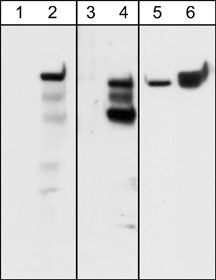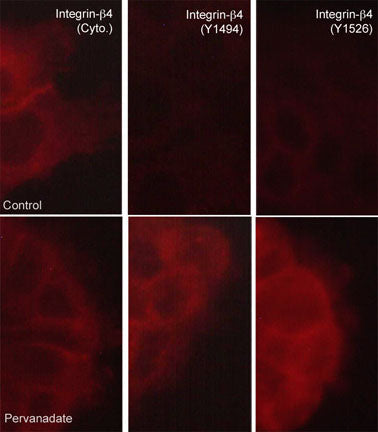Anti-Integrin β4 (Tyr-1526), Phosphospecific Antibody
- SPECIFICATION
- CITATIONS
- PROTOCOLS
- BACKGROUND

Application
| WB |
|---|---|
| Primary Accession | P16144 |
| Reactivity | Bovine |
| Host | Rabbit |
| Clonality | Rabbit Polyclonal |
| Isotype | IgG |
| Calculated MW | 202167 Da |
| Gene ID | 3691 |
|---|---|
| Other Names | integrin, CD104, GP150 |
| Target/Specificity | The NF-κB/Rel transcription factors are present in the cytosol in an inactive state complexed with the inhibitory IκB proteins. Activation of IκBα occurs through both serine and tyrosine phosphorylation events. Activation through phosphorylation at Ser-32 and Ser-36 is followed by proteasome-mediated degradation, resulting in the release and nuclear translocation of active NF-κB. This pathway of IκBα regulation occurs in response to various NF-κB-activating agents, such as TNFα, interleukins, LPS, and irradiation. An alternative pathway for IκBα regulation occurs through tyrosine phosphorylation of Tyr-42 and Tyr-305. Tyr-42 is phosphorylated in response to oxidative stress and growth factors. This phosphorylation can lead to degradation of IκBα and NF-κB-activation. In contrast, Tyr-305 phosphorylation by c-Abl has been implicated in IκBα nuclear translocation and inhibition of NF-κB-activation. Thus, tyrosine phosphorylation of IκBα may be an important regulatory mechanism in NF-κB signaling. |
| Dilution | WB~~1:1000 |
| Storage | Maintain refrigerated at 2-8°C for up to 6 months. For long term storage store at -20°C in small aliquots to prevent freeze-thaw cycles. |
| Precautions | Anti-Integrin β4 (Tyr-1526), Phosphospecific Antibody is for research use only and not for use in diagnostic or therapeutic procedures. |
| Shipping | Blue Ice |

Thousands of laboratories across the world have published research that depended on the performance of antibodies from Abcepta to advance their research. Check out links to articles that cite our products in major peer-reviewed journals, organized by research category.
info@abcepta.com, and receive a free "I Love Antibodies" mug.
Provided below are standard protocols that you may find useful for product applications.
Background
The NF-κB/Rel transcription factors are present in the cytosol in an inactive state complexed with the inhibitory IκB proteins. Activation of IκBα occurs through both serine and tyrosine phosphorylation events. Activation through phosphorylation at Ser-32 and Ser-36 is followed by proteasome-mediated degradation, resulting in the release and nuclear translocation of active NF-κB. This pathway of IκBα regulation occurs in response to various NF-κB-activating agents, such as TNFα, interleukins, LPS, and irradiation. An alternative pathway for IκBα regulation occurs through tyrosine phosphorylation of Tyr-42 and Tyr-305. Tyr-42 is phosphorylated in response to oxidative stress and growth factors. This phosphorylation can lead to degradation of IκBα and NF-κB-activation. In contrast, Tyr-305 phosphorylation by c-Abl has been implicated in IκBα nuclear translocation and inhibition of NF-κB-activation. Thus, tyrosine phosphorylation of IκBα may be an important regulatory mechanism in NF-κB signaling.
If you have used an Abcepta product and would like to share how it has performed, please click on the "Submit Review" button and provide the requested information. Our staff will examine and post your review and contact you if needed.
If you have any additional inquiries please email technical services at tech@abcepta.com.













 Foundational characteristics of cancer include proliferation, angiogenesis, migration, evasion of apoptosis, and cellular immortality. Find key markers for these cellular processes and antibodies to detect them.
Foundational characteristics of cancer include proliferation, angiogenesis, migration, evasion of apoptosis, and cellular immortality. Find key markers for these cellular processes and antibodies to detect them. The SUMOplot™ Analysis Program predicts and scores sumoylation sites in your protein. SUMOylation is a post-translational modification involved in various cellular processes, such as nuclear-cytosolic transport, transcriptional regulation, apoptosis, protein stability, response to stress, and progression through the cell cycle.
The SUMOplot™ Analysis Program predicts and scores sumoylation sites in your protein. SUMOylation is a post-translational modification involved in various cellular processes, such as nuclear-cytosolic transport, transcriptional regulation, apoptosis, protein stability, response to stress, and progression through the cell cycle. The Autophagy Receptor Motif Plotter predicts and scores autophagy receptor binding sites in your protein. Identifying proteins connected to this pathway is critical to understanding the role of autophagy in physiological as well as pathological processes such as development, differentiation, neurodegenerative diseases, stress, infection, and cancer.
The Autophagy Receptor Motif Plotter predicts and scores autophagy receptor binding sites in your protein. Identifying proteins connected to this pathway is critical to understanding the role of autophagy in physiological as well as pathological processes such as development, differentiation, neurodegenerative diseases, stress, infection, and cancer.



